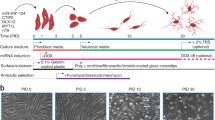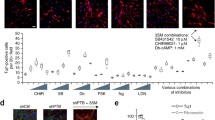Abstract
MicroRNAs (miRNAs), miR-9/9*, and miR-124 (miR-9/9*-124) display fate-reprogramming activities when ectopically expressed in human fibroblasts by erasing the fibroblast identity and evoking a pan-neuronal state. In contrast to induced pluripotent stem cell-derived neurons, miRNA-induced neurons (miNs) retain the biological age of the starting fibroblasts through direct fate conversion and thus provide a human neuron-based platform to study cellular properties inherent in aged neurons and model adult-onset neurodegenerative disorders using patient-derived cells. Furthermore, expression of neuronal subtype-specific transcription factors in conjunction with miR-9/9*-124 guides the miNs to distinct neuronal fates, a feature critical for modeling disorders that affect specific neuronal subtypes. Here, we describe the miR-9/9*-124-based neuronal reprogramming protocols for the generation of several disease-relevant neuronal subtypes: striatal medium spiny neurons, cortical neurons, and spinal cord motor neurons.
Access this chapter
Tax calculation will be finalised at checkout
Purchases are for personal use only
Similar content being viewed by others
References
Ho L, Crabtree GR (2010) Chromatin remodelling during development. Nature 463:474–484. https://doi.org/10.1038/nature08911
Yoo AS, Staahl BT, Chen L, Crabtree GR (2009) MicroRNA-mediated switching of chromatin-remodelling complexes in neural development. Nature 460:642–646. https://doi.org/10.1038/nature08139
Makeyev EV, Zhang J, Carrasco MA, Maniatis T (2007) The MicroRNA miR-124 promotes neuronal differentiation by triggering brain-specific alternative pre-mRNA splicing. Mol Cell 27:435–448. https://doi.org/10.1016/j.molcel.2007.07.015
Conaco C, Otto S, Han J-J, Mandel G (2006) Reciprocal actions of REST and a microRNA promote neuronal identity. PNAS 103:2422–2427. https://doi.org/10.1073/pnas.0511041103
Yoo AS, Sun AX, Li L et al (2011) MicroRNA-mediated conversion of human fibroblasts to neurons. Nature 476:228–231. https://doi.org/10.1038/nature10323
Lu Y-L, Yoo AS (2018) Mechanistic insights into microRNA-induced neuronal reprogramming of human adult fibroblasts. Front Neurosci 12:522. https://doi.org/10.3389/fnins.2018.00522
Horvath S (2013) DNA methylation age of human tissues and cell types. Genome Biol 14:R115. https://doi.org/10.1186/gb-2013-14-10-r115
Huh CJ, Zhang B, Victor MB et al (2016) Maintenance of age in human neurons generated by microRNA-based neuronal conversion of fibroblasts. eLife 5:e18648. https://doi.org/10.7554/eLife.18648
Abernathy DG, Kim WK, McCoy MJ et al (2017) MicroRNAs induce a permissive chromatin environment that enables neuronal subtype-specific reprogramming of adult human fibroblasts. Cell Stem Cell 21:332–348.e9. https://doi.org/10.1016/j.stem.2017.08.002
Lee SW, Oh YM, Lu Y-L et al (2018) MicroRNAs overcome cell fate barrier by reducing EZH2-controlled REST stability during neuronal conversion of human adult fibroblasts. Dev Cell 46:73–84.e7. https://doi.org/10.1016/j.devcel.2018.06.007
Miller JD, Ganat YM, Kishinevsky S et al (2013) Human iPSC-based modeling of late-onset disease via progerin-induced aging. Cell Stem Cell 13:691–705. https://doi.org/10.1016/j.stem.2013.11.006
Patterson M, Chan DN, Ha I et al (2012) Defining the nature of human pluripotent stem cell progeny. Cell Res 22:178–193. https://doi.org/10.1038/cr.2011.133
Mertens J, Paquola ACM, Ku M et al (2015) Directly reprogrammed human neurons retain aging-associated transcriptomic signatures and reveal age-related nucleocytoplasmic defects. Cell Stem Cell 17:705–718. https://doi.org/10.1016/j.stem.2015.09.001
Victor MB, Richner M, Hermanstyne TO et al (2014) Generation of human striatal neurons by microRNA-dependent direct conversion of fibroblasts. Neuron 84:311–323. https://doi.org/10.1016/j.neuron.2014.10.016
McCoy MJ, Paul AJ, Victor MB et al (2018) LONGO: an R package for interactive gene length dependent analysis for neuronal identity. Bioinformatics 34:i422–i428. https://doi.org/10.1093/bioinformatics/bty243
Victor MB, Richner M, Olsen HE et al (2018) Striatal neurons directly converted from Huntington’s disease patient fibroblasts recapitulate age-associated disease phenotypes. Nat Neurosci 21:341–352. https://doi.org/10.1038/s41593-018-0075-7
Richner M, Victor MB, Liu Y et al (2015) MicroRNA-based conversion of human fibroblasts into striatal medium spiny neurons. Nat Protoc 10:1543–1555. https://doi.org/10.1038/nprot.2015.102
Symposium IBGS (2003) The basal ganglia VI. Springer Science & Business Media, Boston, MA
Albin RL, Young AB, Penney JB (1989) The functional anatomy of basal ganglia disorders. Trends Neurosci 12:366–375. https://doi.org/10.1016/0166-2236(89)90074-X
Gerfen CR (1992) The neostriatal mosaic: multiple levels of compartmental organization. Trends Neurosci 15:133–139. https://doi.org/10.1016/0166-2236(92)90355-C
Arlotta P, Molyneaux BJ, Jabaudon D et al (2008) Ctip2 controls the differentiation of medium spiny neurons and the establishment of the cellular architecture of the striatum. J Neurosci 28:622–632. https://doi.org/10.1523/JNEUROSCI.2986-07.2008
Anderson SA, Qiu M, Bulfone A et al (1997) Mutations of the homeobox genes Dlx-1 and Dlx-2 disrupt the striatal subventricular zone and differentiation of late born striatal neurons. Neuron 19:27–37. https://doi.org/10.1016/s0896-6273(00)80345-1
Pang ZP, Yang N, Vierbuchen T et al (2011) Induction of human neuronal cells by defined transcription factors. Nature 476:220–223. https://doi.org/10.1038/nature10202
Heiman M, Schaefer A, Gong S et al (2008) A translational profiling approach for the molecular characterization of CNS cell types. Cell 135:738–748. https://doi.org/10.1016/j.cell.2008.10.028
Lobo MK, Karsten SL, Gray M et al (2006) FACS-array profiling of striatal projection neuron subtypes in juvenile and adult mouse brains. Nat Neurosci 9:443–452. https://doi.org/10.1038/nn1654
Ouimet CC, Greengard P (1990) Distribution of DARPP-32 in the basal ganglia: an electron microscopic study. J Neurocytol 19:39–52. https://doi.org/10.1007/bf01188438
Tsuchida T, Ensini M, Morton SB et al (1994) Topographic organization of embryonic motor neurons defined by expression of LIM homeobox genes. Cell 79:957–970. https://doi.org/10.1016/0092-8674(94)90027-2
Seo SY, Lee B, Lee S (2015) Critical roles of the LIM domains of Lhx3 in recruiting coactivators to the motor neuron-specifying Isl1-Lhx3 complex. Mol Cell Biol 35:3579–3589. https://doi.org/10.1128/MCB.00335-15
Farah MH, Olson JM, Sucic HB et al (2000) Generation of neurons by transient expression of neural bHLH proteins in mammalian cells. Development 127:693–702
Olson JM, Asakura A, Snider L et al (2001) NeuroD2 is necessary for development and survival of central nervous system neurons. Dev Biol 234:174–187. https://doi.org/10.1006/dbio.2001.0245
Jiang W, Hua R, Wei M et al (2015) An optimized method for high-titer lentivirus preparations without ultracentrifugation. Sci Rep 5:1–9. https://doi.org/10.1038/srep13875
Chanda S, Ang CE, Lee QY et al (2019) Direct reprogramming of human neurons identifies MARCKSL1 as a pathogenic mediator of valproic acid-induced teratogenicity. Cell Stem Cell 25:103–119.e6. https://doi.org/10.1016/j.stem.2019.04.021
Acknowledgments
The authors thank Shawei Chen for his inputs related to the protocol. V.A.C. is supported by a fellowship from the William N. and Bernice E. Bumpus Foundation. This work was supported by grants from NIH (RF1AG056296 and R01NS107488), CHDI foundation, Farrell Fund, and Collaborative Center for X-linked Dystonia Parkinsonism (CC-XDP) to A.S.Y.
Author information
Authors and Affiliations
Corresponding author
Editor information
Editors and Affiliations
Rights and permissions
Copyright information
© 2021 Springer Science+Business Media, LLC, part of Springer Nature
About this protocol
Cite this protocol
Church, V.A., Cates, K., Capano, L., Aryal, S., Kim, W.K., Yoo, A.S. (2021). Generation of Human Neurons by microRNA-Mediated Direct Conversion of Dermal Fibroblasts. In: Hu, K. (eds) Nuclear Reprogramming. Methods in Molecular Biology, vol 2239. Humana, New York, NY. https://doi.org/10.1007/978-1-0716-1084-8_6
Download citation
DOI: https://doi.org/10.1007/978-1-0716-1084-8_6
Published:
Publisher Name: Humana, New York, NY
Print ISBN: 978-1-0716-1083-1
Online ISBN: 978-1-0716-1084-8
eBook Packages: Springer Protocols




